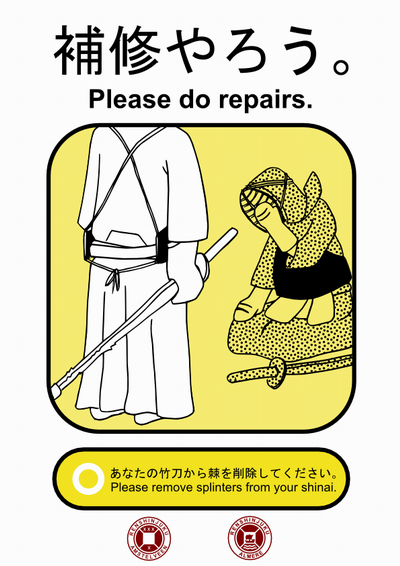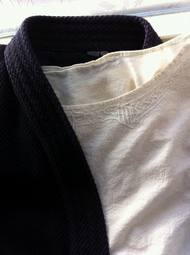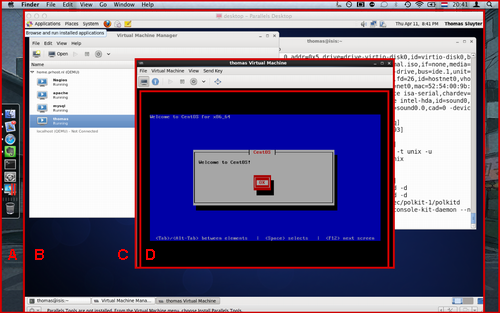

2013-04-28 21:03:00
Today was hard work! Over sixty people traveled to Sporthallen Zuid in Amsterdam for the national level 'central training'. This month's edition focused on shiai and shinpan skills, meaning both the fighting and the referreeing of competitions. Today, Renshinjuku's turnup was also impressive with a dozen members attending. Excellent :)
It was a lot to take in! Before lunch, Mark Herbold-sensei took us through kihon in order to practice legwork and speed. He impressed upon us the importance of moving from the legs and hips, with 80% of your effort coming from there. The remaining effort is 10% stomach to retain posture, then 8% and 2% left/right hands for the strike. By properly using your hips and legs you assure that you close in quickly and that you retain control of the situation.
Exercises included kirikaeshi, oki-men, oki-kote-men, hayai kote-men and then a number of hayai variations of kote-men, kote-men-men, kote-kote-men, kote-men-kote-men and so on. In each of these, the connection and distance between both kendoka was key: kakarite needs to move in fast enough to pressure motodachi backwards. Motodachi needs to be surprised and should not dance backwards before the attach. Learning this speed and pressure is what will help you overwhelm your opponent in shiai.
After lunch Vitalis-sensei went over a few basics regarding referreeing: valid strikes and hansoku (violations).
A valid point only has the following five requirements:
Salmon-sensei has written a little more about what makes a valid ippon. Vitalis-sensei remarked that many things that we learn are important for a strike (like ki-ken-tai-ichi) are NOT in the rulebook. This means they are NOT required for ippon. He also impressed upon us that there are two common mistakes that beginning shinpan make:
After Louis' introduction the sixty kendoka were divided across three shiaijo, each led by a high ranking sensei. I was assigned to Mark Herbold-sensei's shiaijo. He led the session with clear instructions and a pleasant amount of humor. He explained so many things, it's hard to remember them all. The following will simply be a stream of conciousness, trying to recall as much as possible of what was said.
The following points were made for me specifically:
The last hour of the day was free jigeiko. Sadly I had to leave early, but I'll get another chance later :)
kilala.nl tags: kendo, sports,
View or add comments (curr. 0)
2013-04-22 23:40:00

I recently found myself inspired by Bunpei Yorifuji's famous "Please do it..." campaign posters promoting etiquette in the Tokyo subway. They are catchy, they're a bit funny and they manage to drive home a message clearly.
"What if", I thought, "we applied the same design esthetic and message to kendo?". Thus work has started on a kendo-centric set of "Please do it..." posters. First up, based on last weekend's shinai inspection, is a poster about maintenance. It is everybody's duty to ensure their equipment is safe and that no harm can be done to your fellow kendoka. Loose splinters on shinai may pierce somebody's eye!
The Japanese sentences were made using JEDict and Google Translate, so I'm sure they're full of mistakes. Please correct me!
kilala.nl tags: kendo, creative,
View or add comments (curr. 0)
2013-04-20 08:13:00

With summer coming up I'm looking for ways to minimize wear and tear on my keikogi, the thick jackets we wear in kendo. The keikogi suck up loads of sweat and thus become pretty dirty very quickly. Unfortunately they also fade quickly and the rice-grain pattern also wears out pretty quickly if you launder them often.
Traditionally, to keep expensive silk kimono clean, people wear juban which is a simple cotton undershirt. When I say "simple" I mean "less elaborate than a kimono", just check out the Pinterest on juban. There are even simpler juban, which look like thin white keikogi, sold by budogu such as Yamato. And that's exactly what I need, but I'll be damned if I pay $30-$40 for a simple shirt! That sewing machine isn't simply gathering dust in the attic!
Because I don't have any cotton lying around just now, I've modified a few of my old projects. Years and years back, when I was still in the SCA, I made two cotton under-tunics. Meant to be worn under my full-length tunic as an extra layer, they were thigh-length and had long sleeves. In order for them to be worn as juban, I have shortened the sleeves and the body so they don't show from under my keikogi.
So now I have two neat undershirts for kendo... And they even have embroidery on them!
And to think I made those things fourteen years ago! Fourteen! ( O_o)
kilala.nl tags: kendo, creative,
View or add comments (curr. 2)
2013-04-17 08:11:00
Hoooo boy, last night's training was good! Despite my hay fever I soldiered on and because of that I was dead tired when I came home. I managed to unpack my equipment bag, but nothing more. The moment my head hit the pillow I was g.o.n.e. Boom. I showered at the office just now ;)
Last week and yesterday class was led by Jouke-sempai, who was in the Netherlands for last weekend's EKC. Where we usually practice upwards of six techniques a night in 2x(2x5) bouts, he now had us repeating the same technique in a 2x(5min) setup. This dramatically lowered the amount of different things we got to try, but there are two huge benefits:
During kihon practice we focused on men (both oki and hayai), hayai kote and kote-men and finally hiki waza. The following points were made:
The past weeks, Hillen-sempai and Ton-sensei reprimanded me for my horrible hayai kote. I keep going in arcs, which messes up the practice we're doing. Yesterday I got the same reprimand from Miyahara-sensei. She had me do it over and over again, until I started showing something resembling a good kote-strike. Straight and through the center, no need to raise it high, no need to go wide.
Tsuyuguchi-sensei spent a lot of his time explaining hiki waza to me. Most of it was in Japanese (probably because I had given the impression that I speak it) so I missed big parts of it. However, the essence of what he tried to convey is this:
I really appreciate the effort he put into explaining these things to me! It's the first time we've really spoken, so I went up to him after class to thank him again. Point #3 is a bit confusing for me, because I have often been told not to put any pressure in tsubazeriai. Not until you actually push off for your strike.
In jigeiko I had the chance to spar with Miyahara-sensei, who went over hayai kote with me some more. Try, try, try and try again. We also tried a number of other techniques, with her seemingly focussing on hayai men and debana kote. I also started jigeiko with Onno-sempai, but I had to bow out early because of my dizziness (thankyouverymuch hay fever). I spent the last ten minutes of class helping out our kouhai Gaby in practicing her kote strikes and footwork.
I haven't written much about kendo the past two months. Here's what happened.
kilala.nl tags: kendo, sports,
View or add comments (curr. 0)
2013-04-11 20:45:00

I'm currently studying for my RHCSA certification. As part of the exam I will need to work with KVM virtual machines, which require a proper piece of hardware to run on.
Sadly I haven't been able to boot CentOS off a USB drive on my Macbook, despite numerous attempts. I've had a number of great tutorials, but no dice. Luckily my colleague Peter (not the one of the iMac) came to the rescue! He runs a sandbox system at home, which is a great playground to study for the RHCSA. He gave me an account and permissions to fiddle with KVM.
Which is what landed me with the screenshot above. That's:
kilala.nl tags: work, sysadmin, geeky,
View or add comments (curr. 2)
All content, with exception of "borrowed" blogpost images, or unless otherwise indicated, is copyright of Tess Sluijter. The character Kilala the cat-demon is copyright of Rumiko Takahashi and used here without permission.